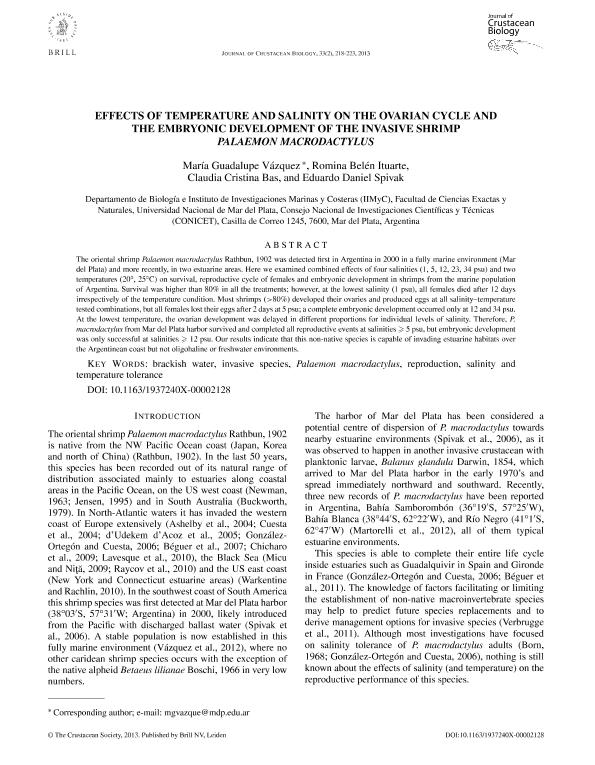Artículo
Effects of temperature and salinity on the ovarian cycle and the embryonic development of the invasive shrimp Palaemon macrodactylus
Fecha de publicación:
02/2013
Editorial:
Crustacean Society
Revista:
Journal of Crustacean Biology
ISSN:
0278-0372
Idioma:
Inglés
Tipo de recurso:
Artículo publicado
Clasificación temática:
Resumen
The oriental shrimp Palaemon macrodactylus Rathbun, 1902 was detected first in Argentina in 2000 in a fully marine environment (Mar del Plata) and more recently, in two estuarine areas. Here we examined combined effects of four salinities (1, 5, 12, 23, 34 psu) and two temperatures (20°, 25°C) on survival, reproductive cycle of females and embryonic development in shrimps from the marine population of Argentina. Survival was higher than 80% in all the treatments; however, at the lowest salinity (1 psu), all females died after 12 days irrespectively of the temperature condition. Most shrimps (>80%) developed their ovaries and produced eggs at all salinity?temperature tested combinations, but all females lost their eggs after 2 days at 5 psu; a complete embryonic development occurred only at 12 and 34 psu. At the lowest temperature, the ovarian development was delayed in different proportions for individual levels of salinity. Therefore, P. macrodactylus from Mar del Plata harbor survived and completed all reproductive events at salinities 5 psu, but embryonic development was only successful at salinities 12 psu. Our results indicate that this non-native species is capable of invading estuarine habitats over the Argentinean coast but not oligohaline or freshwater environments.
Archivos asociados
Licencia
Identificadores
Colecciones
Articulos(IIMYC)
Articulos de INSTITUTO DE INVESTIGACIONES MARINAS Y COSTERAS
Articulos de INSTITUTO DE INVESTIGACIONES MARINAS Y COSTERAS
Citación
Vázquez, María Guadalupe; Ituarte, Romina Belen; Bas, Claudia Cristina; Spivak, Eduardo Daniel; Effects of temperature and salinity on the ovarian cycle and the embryonic development of the invasive shrimp Palaemon macrodactylus; Crustacean Society; Journal of Crustacean Biology; 33; 2; 2-2013; 218-223
Compartir
Altmétricas




